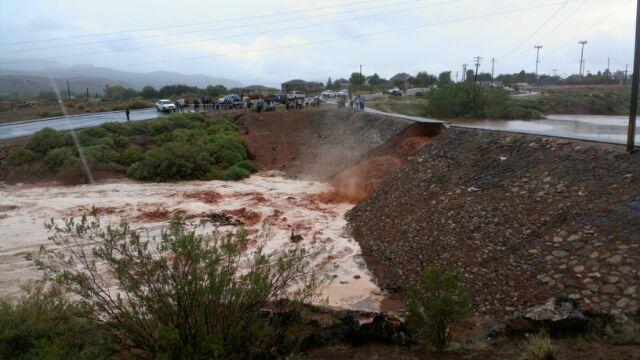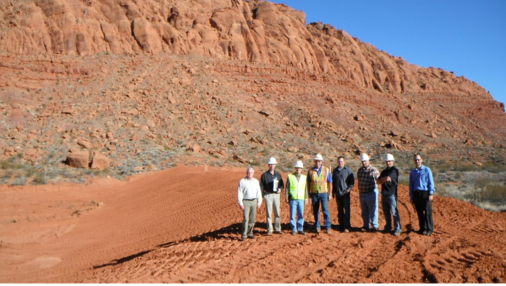
WASHINGTON COUNTY – Flood events in Washington County have taken a toll the last few years and to help mitigate flood damage, the county’s cities banded together to form the Washington County Flood Control Authority in September 2011, which has eased all of their burdens.
Since the Virgin and Santa Clara rivers run through more than one city, the Flood Control Authority was established to provide a pool of funding for flood control measures along the rivers and for regional flood control facilities, such as debris basins and storm detention basins, to be improved and maintained, said Santa Clara City Councilman Jerry Amundsen, a member of the authority’s executive committee.
It is an interlocal cooperative between Washington County, St. George, Washington City, and Santa Clara, who are all participating, voting members. The authority is governed by an executive committee made up of elected officials from the three cities and a technical advisory committee, which includes city staff members involved in public works. Hurricane and Ivins are participating but nonvoting members.
The FCA’s mission is to deal with overlapping areas of drainage and facilities that impact more than one municipality, St. George City Engineer Jay Sandberg said. Sandberg serves as chair of the agency’s technical advisory committee. The Flood Control Authority utilizes existing manpower and resources from each of its member cities to keep expenses minimal, he said.
For instance, the amount of assessment fees collected by a smaller city such as Santa Clara would pale in comparison to that collected by St. George, Amundsen said.
“Construction or maintenance of regionally significant facilities would take a smaller city many years to fund — which could be too late,” he said.

That was perfectly illustrated approximately two years ago when the Laub Pond detention facility in Santa Clara failed during a significant storm event.
“We were able to receive FEMA (Federal Emergency Management Agency) funding for replacement of the facility and to cover damages to city-owned infrastructure,” he said.
But the governmental assistance comes with a 20 percent match requirement, Amundsen said, and Santa Clara is not able to hold a significant amount of money in reserve, so the city would have struggled to come up with the match amount. Additionally, the facility had to be constructed immediately before another significant storm, otherwise the downstream homes would remain unprotected and be at risk of additional flooding, Amundsen explained.
“Being associated with the flood control authority enabled us to tap into that funding pool and pay for the federal match,” he said. “The Laub Pond facility was reconstructed before the potential heavy rain season started the following summer.”

FEMA covered 75 percent of the cost to rebuild Laub Pond while the FCA was in charge of the remaining 25 percent, Sandberg said.
In addition to Laub Pond, other projects the authority has worked on include the Washington Fields drainage and trailways project, which covers 22 square miles of drainage between Washington and St. George cities, Sandberg said. The agency has also worked on the Stucki Farm flood basin and rebuilt the lower Tuacahn basin. The authority applies for and facilitates grants from the government and other sources to help fund such projects, he said.
The FCA has also worked on parts of the Virgin River channel common to both St. George and Washington City, Sandberg said, including tamarisk and sediment removal, revegetation and the coordination and funding of improvements and maintenance on the flood control walls built by the Natural Resource Conservation Service after the 2005 flood.
“The flood control authority simply allows Washington County and the associated cities a conglomerated benefit,” Amundsen said. “Rather than taking on flood control issues by ourselves, with limited expertise and resources, we can pull from experience, training, and resources established by the combined group.”
Related posts
- State officials mandate Virgin River water cuts; future uncertain
- Agencies optimistic about tamarisk removal
- Angell Heights Estates in Hurricane threatened by heavy rainfall, flooding; STGnews Photo Gallery
- Tuacahn Wash Detention Dam completed, adds flood protection, tortoise habitat respected
- Santa Clara/Ivins Public Safety merger leads to further sister-city cooperation
- Santa Clara to receive federal disaster funds
Email: [email protected]
Twitter: @STGnews
Copyright St. George News, SaintGeorgeUtah.com LLC, 2014, all rights reserved.
The Santa Clara flood was not a “flood” compared to the 2005 flood, where flood waters rose from rain. It was a “flood” on a small area of Santa Clara because of the failure of the city nimrods doing their GD job. As you can see from the photo, it never actually crested the trail. It eroded due to the gopher holes. One of a few weak spots where there were holes and then the water poured through and eroded from the inside out. And there was no drainage for the water collected to run out. So, lets give a true flood the credit it deserves. And call Santa Clara what it is. A bunch of friends and family running a town who are at best “inept”. Someone screwed the pooch on that one. Had this happened in the middle of the night, children could have been killed as they slept in their basements. That water hit so fast and hard that homes were knocked off their foundations. Just because nobody actually died doesn’t mean they get a pass. Perhaps they should invest more in qualified city engineers and less in Santa Clara Swiss Days.
YOUR WHINING HERE ISN’T GOING TO DO ANY GOOD
A flood control district is great way to deal with many of the problems which would not have occurred in the first place had the cities and county been more proactive in zoning flood areas and denying building in those zones.
.
Prime example is the Virgin River above the convention center. It is completely unregulated meaning no dams on it to contain flooding. It will flood big in the future and there will be major damage all along the river to buildings and roads from the convention center upstream. These lands should have been preserved as open space or for agriculture.
.
One of the very first lessons the St George Mormon pioneers learned in 1861-1862 is that the Virgin is a capricious, ill-tempered hell-b***. I don’t expect that the money grubbing developers, and the local political leaders who can’t say no to them, will ever learn from the past. We’ll keep building where we shouldn’t and then beg the federal government, that we all despise, for money to fix our stupidity.
BOBBER, YOU ARE AN IDIOT. YOU JUST LIKE TO BE THE FIRST TO WHINE, BY THE LOOKS OF YOUR PREVIOUS POSTS. THESE ARE FACTS. DID I WHINE? ONLY ABOUT THE INEPTITUDE OF A CERTAIN CITY. SUCK IT.
Bobber get back in your trailer and ….
Ed. ellipsis.